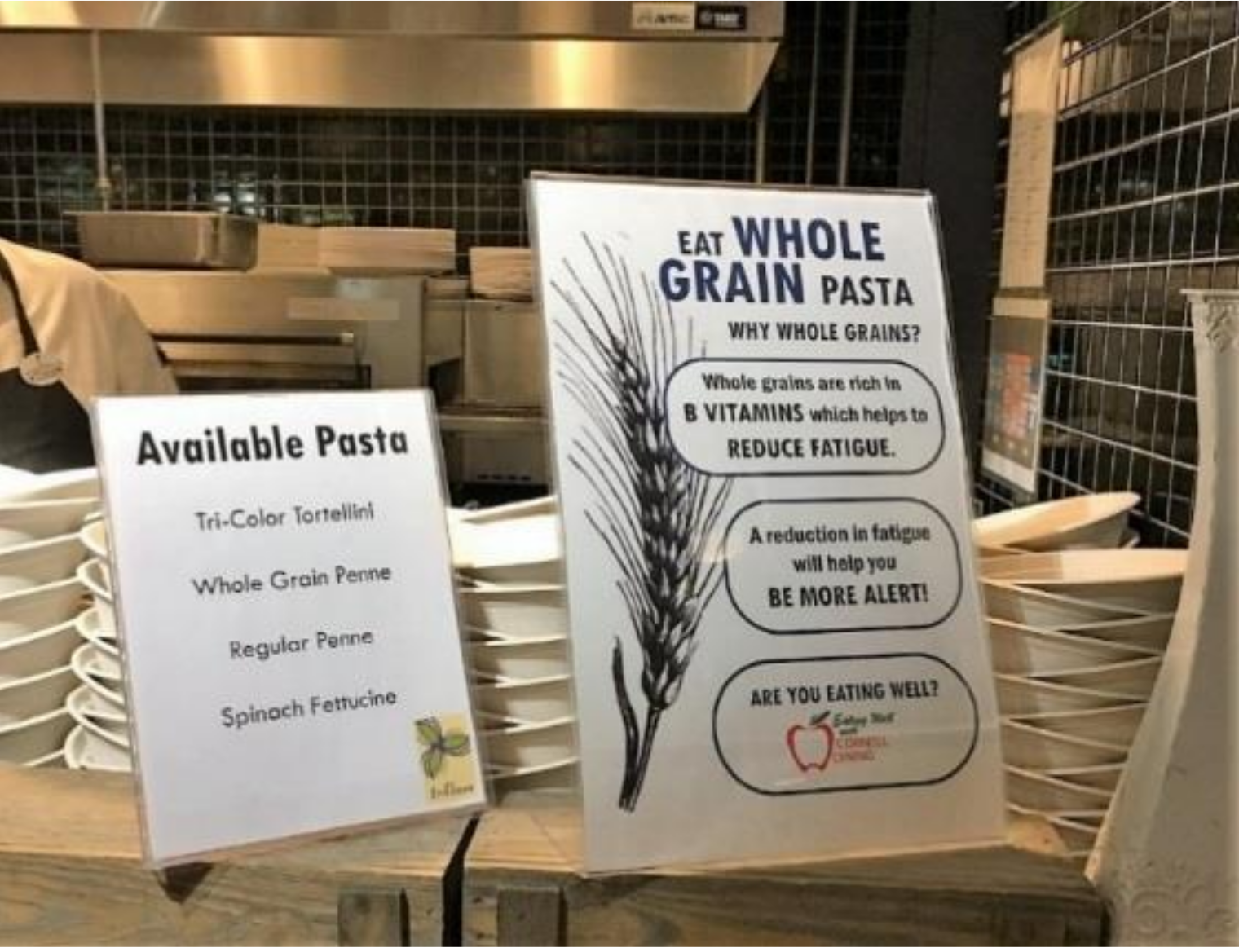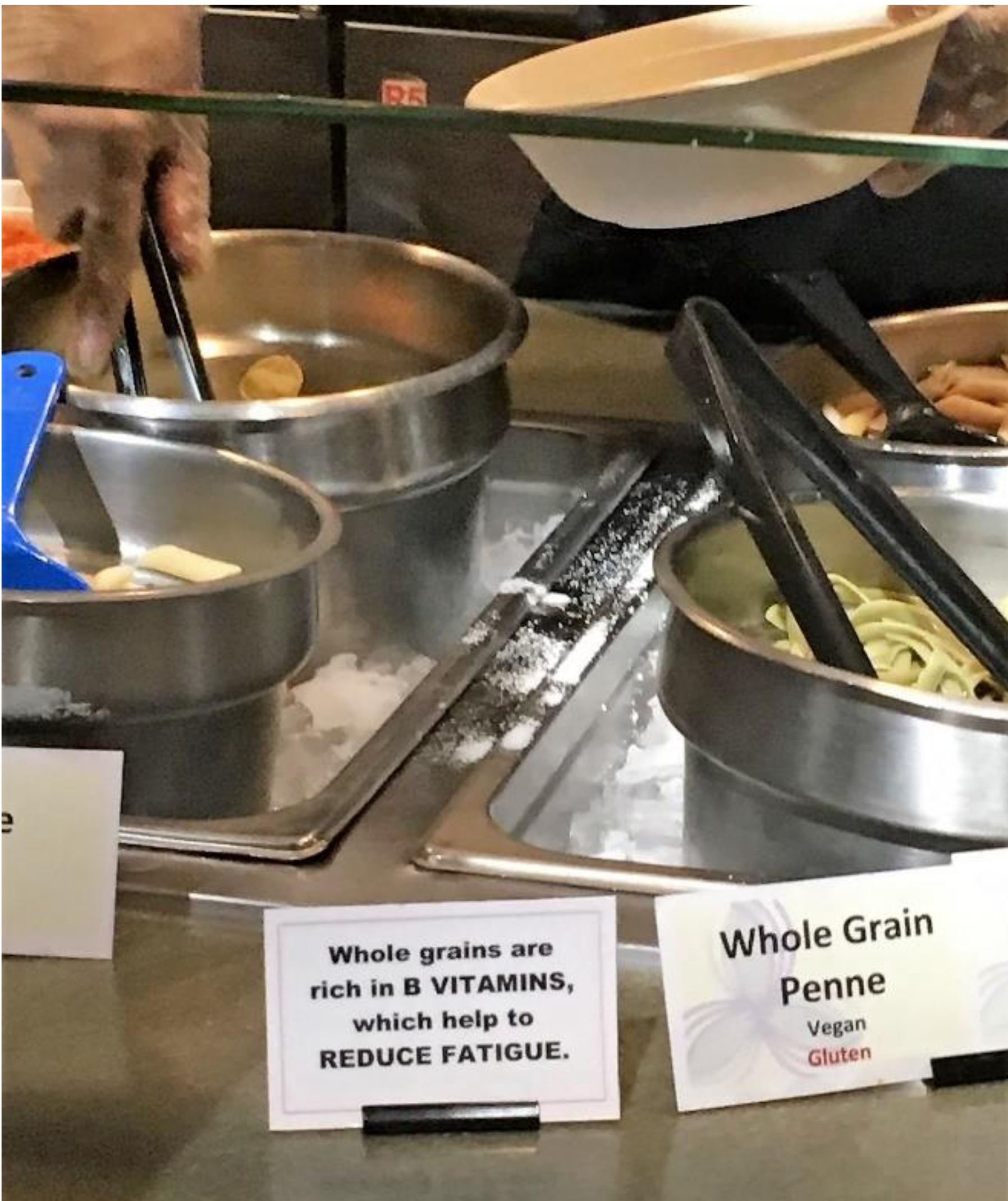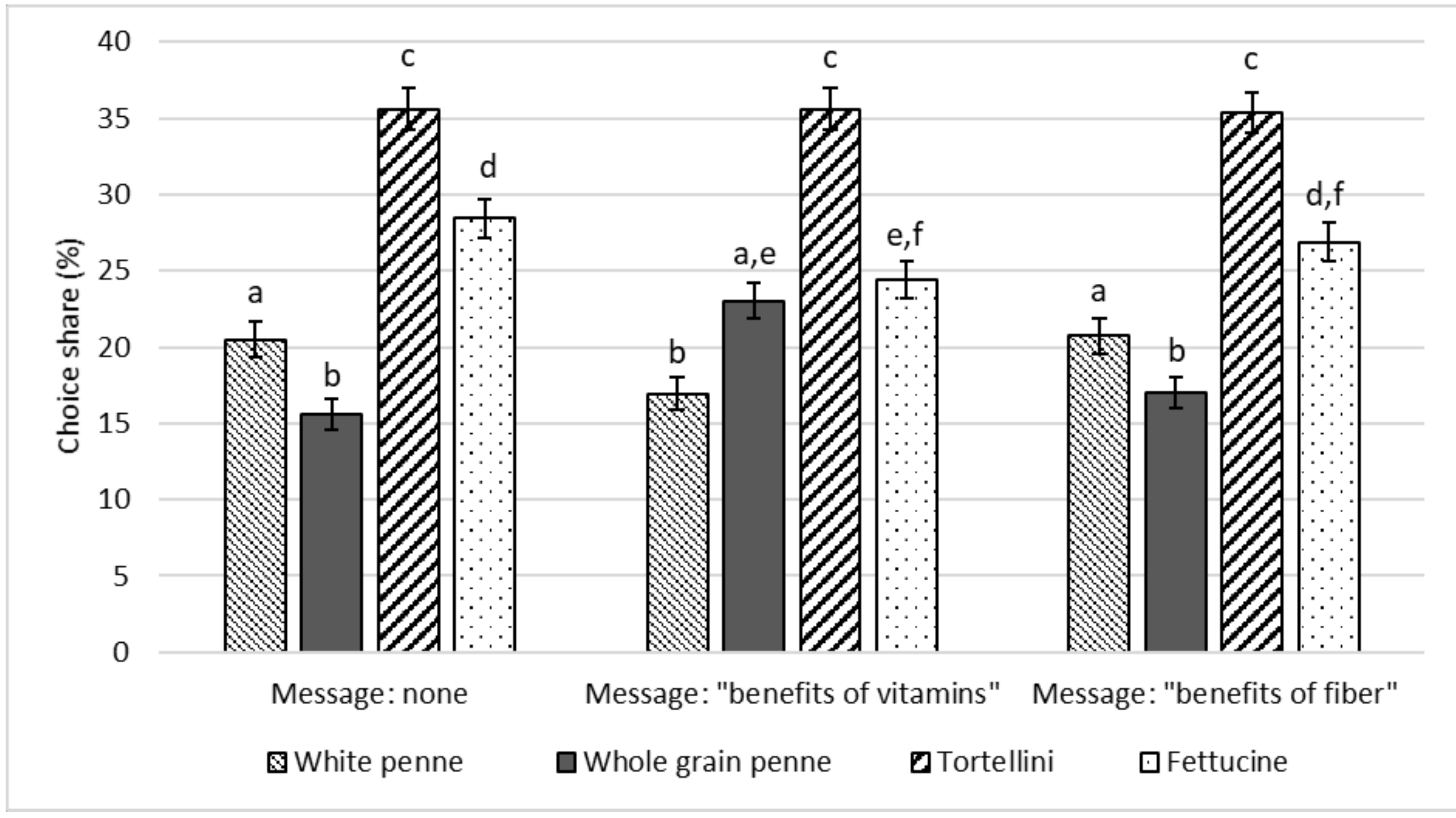The Influence of Health Messages in Nudging Consumption of Whole Grain Pasta
Abstract
1. Introduction
2. Background
3. Materials and Methods
3.1. Data Collection
3.2. Data Analysis
4. Results
5. Discussion
5.1. Implications
5.2. Strengths and Limitations
6. Conclusions and Future Studies
Author Contributions
Funding
Acknowledgments
Conflicts of Interest
Appendix A


References
- Sogari, G.; Velez-Argumedo, C.; Gómez, M.; Mora, C. College Students and Eating Habits: A Study Using An Ecological Model for Healthy Behavior. Nutrients 2018, 10, 1823. [Google Scholar] [CrossRef] [PubMed]
- Deliens, T.; Van Crombruggen, R.; Verbruggen, S.; De Bourdeaudhuij, I.; Deforche, B.; Clarys, P. Dietary interventions among university students: A systematic review. Appetite 2016, 105, 14–26. [Google Scholar] [CrossRef] [PubMed]
- Crombie, A.P.; Ilich, J.Z.; Dutton, G.R.; Panton, L.B.; Abood, D.A. The freshman weight gain phenomenon revisited. Nutr. Rev. 2009, 67, 83–94. [Google Scholar] [CrossRef] [PubMed]
- World Health Organization. Obesity and Overweight. Available online: https://www.who.int/en/news-room/fact-sheets/detail/obesity-and-overweight (accessed on 21 October 2019).
- World Health Organization. Noncommunicable Diseases: The Slow Motion Disaster; WHO: Geneva, Switzerland, 2017. [Google Scholar]
- Department of Health and Human Service. Food and Drug Admisistration Federal Register Volume 81, Issue 103 (May 27, 2016); Department of Health and Human Service: Washington, DC, USA, 2016.
- U.S. Department of Health and Human Services and U.S. Department of Agriculture. 2015–2020 Dietary Guidelines for Americans; ODPHP: Washington, DC, USA, 2015.
- Jones, J.M.; Engleson, J. Whole Grains: Benefits and Challenges. Annu. Rev. Food Sci. Technol. 2010, 1, 19–40. [Google Scholar] [CrossRef] [PubMed]
- Ye, E.Q.; Chacko, S.A.; Chou, E.L.; Kugizaki, M.; Liu, S. Greater whole-grain intake is associated with lower risk of type 2 diabetes, cardiovascular disease, and weight gain. J. Nutr. 2012, 142, 1304–1313. [Google Scholar] [CrossRef] [PubMed]
- O’Neil, C.E.; Nicklas, T.A.; Zanovec, M.; Cho, S.S.; Kleinman, R. Consumption of whole grains is associated with improved diet quality and nutrient intake in children and adolescents: The National Health and Nutrition Examination Survey 1999–2004. Public Health Nutr. 2011, 14, 347–355. [Google Scholar] [CrossRef]
- McGill, C.R.; Fulgoni, V.L., III; Devareddy, L. Ten-Year Trends in Fiber and Whole Grain Intakes and Food Sources for the United States Population: National Health and Nutrition Examination Survey 2001–2010. Nutrients 2015, 7, 1119–1130. [Google Scholar] [CrossRef]
- Shepherd, R.; Dean, M.; Lampila, P.; Arvola, A.; Saba, A.; Vassallo, M.; Claupein, E.; Winkelmann, M.; Lähteenmäki, L. Communicating the benefits of wholegrain and functional grain products to European consumers. Trends Food Sci. Technol. 2012, 25, 63–69. [Google Scholar] [CrossRef]
- European Commission. Whole Grain. Available online: https://ec.europa.eu/jrc/en/health-knowledge-gateway/promotion-prevention/nutrition/whole-grain (accessed on 21 October 2019).
- Lattimer, J.M.; Haub, M.D. Effects of dietary fiber and its components on metabolic health. Nutrients 2010, 2, 1266–1289. [Google Scholar] [CrossRef]
- De Munter, J.S.L.; Hu, F.B.; Spiegelman, D.; Franz, M.; Van Dam, R.M. Whole grain, bran, and germ intake and risk of type 2 diabetes: A prospective cohort study and systematic review. PLoS Med. 2007, 4, e261. [Google Scholar] [CrossRef]
- Anderson, J.W. Whole grains and coronary heart disease: The whole kernel of truth. Am. J. Clin. Nutr. 2004, 80, 1459–1460. [Google Scholar] [CrossRef] [PubMed][Green Version]
- Quick, V.; Wall, M.; Larson, N.; Haines, J.; Neumark-Sztainer, D. Personal, behavioral and socio-environmental predictors of overweight incidence in young adults: 10-yr longitudinal findings. Int. J. Behav. Nutr. Phys. Act. 2013, 10, 37. [Google Scholar] [CrossRef] [PubMed]
- Martini, D.; Brusamolino, A.; Del Bo’, C.; Laureati, M.; Porrini, M.; Riso, P. Effect of fiber and protein-enriched pasta formulations on satiety-related sensations and afternoon snacking in Italian healthy female subjects. Physiol. Behav. 2018, 185, 61–69. [Google Scholar] [CrossRef] [PubMed]
- Sadler, M. 13-Authorised EU health claims for vitamins and minerals. In Foods, Nutrients and Food Ingredients with Authorised Eu Health Claims; Woodhead Publishing: Cambridge, UK, 2014; pp. 274–297. ISBN 9780857098429. [Google Scholar]
- EFSA Panel on Dietetic Products, Nutrition and Allergies (NDA) Scientific Opinion on the substantiation of health claims related to niacin and reduction of tiredness and fatigue (ID 47), contribution to normal energy-yielding metabolism (ID 51), contribution to normal psychological functions (ID 55), maintenance of normal blood flow (ID 211), and maintenance of normal skin and mucous membranes (ID 4700) pursuant to Article 13 (1) of Regulation (EC) No 1924/2006. EFSA J. 2010, 8, 1757.
- European Commission. COMMISSION REGULATION (EU) No 432/2012 of 16 May 2012 Establishing a List of Permitted Health Claims Made on Foods, Other Than Those Referring to the Reduction of Disease Risk and to Children’s Development and Health; European Commission: Brussels, Belgium, 2012; Volume 136. [Google Scholar]
- European Commission. Regulation (EC) No 1924/2006 of the European Parliament and of the Council of 20 December 2006 on Nutrition and Health Claims Made on Foods. Off. J. Eur. Union L 2006, 404, 9–25. [Google Scholar]
- Food and Drug Administration Guidance for Industry: Evidence-Based Review System for the Scientific Evaluation of Health Claims. Available online: https://www.fda.gov/regulatory-information/search-fda-guidance-documents/guidance-industry-evidence-based-review-system-scientific-evaluation-health-claims (accessed on 21 October 2019).
- Binns, N. 1-The regulation of health claims in Europe. In Foods, Nutrients and Food Ingredients with Authorised Eu Health Claims; Woodhead Publishing: Cambridge, UK, 2014; pp. 3–22. ISBN 9780857098429. [Google Scholar]
- Christoph, M.J.; An, R.; Ellison, B. Correlates of nutrition label use among college students and young adults: A review. Public Health Nutr. 2016, 19, 2135–2148. [Google Scholar] [CrossRef]
- Thaler, R.H.; Sunstein, C.R. Nudge: Improving Decisions about Health, Wealth, and Happiness; Yale University Press: New Haven, CT, USA, 2008; ISBN 978-0-300-12223-7. [Google Scholar]
- Van Kleef, E.; Van Trijp, H.C.M. Methodological Challenges of Research in Nudging. In Methods in Consumer Research, Volume 1; Woodhead Publishing: Cambridge, UK, 2018; pp. 329–349. [Google Scholar]
- Leng, G.; Adan, R.A.H.; Belot, M.; Brunstrom, J.M.; De Graaf, K.; Dickson, S.L.; Hare, T.; Maier, S.; Menzies, J.; Preissl, H.; et al. The determinants of food choice. Proc. Nutr. Soc. 2017, 76, 316–327. [Google Scholar] [CrossRef]
- Vecchio, R.; Cavallo, C. Increasing healthy food choices through nudges: A systematic review. Food Qual. Prefer. 2019, 78, 103714. [Google Scholar] [CrossRef]
- Peterson, S.; Duncan, D.P.; Null, D.B.; Roth, S.L.; Gill, L. Positive changes in perceptions and selections of healthful foods by college students after a short-term point-of-selection intervention at a dining hall. J. Am. Coll. Health 2010, 58, 425–431. [Google Scholar] [CrossRef]
- Buscher, L.A.; Martin, K.A.; Crocker, S. Point-of-purchase messages framed in terms of cost, convenience, taste, and energy improve healthful snack selection in a college foodservice setting. J. Am. Diet. Assoc. 2001, 101, 909–913. [Google Scholar] [CrossRef]
- Freedman, M.R.; Connors, R. Point-of-purchase nutrition information influences food-purchasing behaviors of college students: A pilot study. J. Am. Diet. Assoc. 2010, 110, 1222–1226. [Google Scholar] [CrossRef] [PubMed]
- Roy, R.; Kelly, B.; Rangan, A.; Allman-Farinelli, M. Food Environment Interventions to Improve the Dietary Behavior of Young Adults in Tertiary Education Settings: A Systematic Literature Review. J. Acad. Nutr. Diet. 2015, 115, 1647–1681. [Google Scholar] [CrossRef] [PubMed]
- De Wijk, R.A.; Maaskant, A.J.; Polet, I.A.; Holthuysen, N.T.E.; Van Kleef, E.; Vingerhoeds, M.H. An In-Store Experiment on the Effect of Accessibility on Sales of Wholegrain and White Bread in Supermarkets. PLoS ONE 2016, 11, e0151915. [Google Scholar] [CrossRef] [PubMed]
- Van Kleef, E.; Seijdell, K.; Vingerhoeds, M.H.; De Wijk, R.A.; Van Trijp, H.C.M. The effect of a default-based nudge on the choice of whole wheat bread. Appetite 2018, 121, 179–185. [Google Scholar] [CrossRef] [PubMed]
- Martini, D.; Ciccoritti, R.; Nicoletti, I.; Nocente, F.; Corradini, D.; D’Egidio, M.G.; Taddei, F. From seed to cooked pasta: Influence of traditional and non-conventional transformation processes on total antioxidant capacity and phenolic acid content. Int. J. Food Sci. Nutr. 2018, 69, 24–32. [Google Scholar] [CrossRef] [PubMed]
- Brennan, C.S. 13-Fibre-enriched and whole wheat pasta. In Woodhead Publishing Series in Food Science, Technology and Nutrition; Delcour, J.A., Poutanen, K.B.T.-F.-R., Eds.; Woodhead Publishing: Cambridge, UK, 2013; pp. 273–290. ISBN 978-0-85709-038-6. [Google Scholar]
- Larson, N.I.; Neumark-Sztainer, D.; Story, M.; Burgess-Champoux, T. Whole-Grain Intake Correlates among Adolescents and Young Adults: Findings from Project EAT. J. Acad. Nutr. Diet. 2010, 110, 230–237. [Google Scholar] [CrossRef] [PubMed]
- The Culinary Institute of America. Menus of Change, 2017 Annual Report; The Culinary Institute of America: New York, NY, USA, 2017. [Google Scholar]
- Sunstein, C. Nudging: A Very Short Guide. J. Consum. Policy 2014, 37, 583–588. [Google Scholar] [CrossRef]
- Siegrist, M.; Stampfli, N.; Kastenholz, H. Consumers’ willingness to buy functional foods. The influence of carrier, benefit and trust. Appetite 2008, 51, 526–529. [Google Scholar] [CrossRef]
- Truswell, A.S. Cereal grains and coronary heart disease. Eur. J. Clin. Nutr. 2002, 56, 1–14. [Google Scholar] [CrossRef]
- U.S.D.A FoodData. Central Agricultural Research Service. Available online: Fdc.nal.usda.gov (accessed on 21 October 2019).
- EFSA Panel on Dietetic Products, Nutrition and Allergies (NDA) Scientific Opinion on the substantiation of health claims related to wheat bran fibre and increase in faecal bulk (ID 3066), reduction in intestinal transit time (ID 828, 839, 3067, 4699) and contribution to the maintenance or achievement of a normal body weight (ID 829) pursuant to Article 13 (1) of Regulation (EC) No 1924/2006. EFSA J. 2010, 8, 1817.
- Wills, J.M.; Bonsmann, S.; Kolka, M.; Grunert, K.G. Symposium 2: Nutrition and health claims: Help or hindrance: European consumers and health claims: Attitudes, understanding and purchasing behaviour. Proc. Nutr. Soc. 2012, 71, 229–236. [Google Scholar] [CrossRef] [PubMed]
- Köster, E.P. Diversity in the determinants of food choice: A psychological perspective. Food Qual. Prefer. 2009, 20, 70–82. [Google Scholar] [CrossRef]
- Kamar, M.; Evans, C.; Hugh-Jones, S. Factors influencing adolescent whole grain intake: A theory-based qualitative study. Appetite 2016, 101, 125–133. [Google Scholar] [CrossRef] [PubMed]
- McMackin, E.; Dean, M.; Woodside, J.V.; McKinley, M.C. Whole grains and health: Attitudes to whole grains against a prevailing background of increased marketing and promotion. Public Health Nutr. 2013, 16, 743–751. [Google Scholar] [CrossRef] [PubMed]
- Burgess-Champoux, T.; Marquart, L.; Vickers, Z.; Reicks, M. Perceptions of children, parents, and teachers regarding whole-grain foods, and implications for a school-based intervention. J. Nutr. Educ. Behav. 2006, 38, 230–237. [Google Scholar] [CrossRef]
- Marquart, L.; Pham, A.-T.; Lautenschlager, L.; Croy, M.; Sobal, J. Beliefs about whole-grain foods by food and nutrition professionals, health club members, and special supplemental nutrition program for women, infants, and children participants/State fair attendees. J. Am. Diet. Assoc. 2006, 106, 1856–1860. [Google Scholar] [CrossRef]
- Verbeke, W. Agriculture and the food industry in the information age. Eur. Rev. Agric. Econ. 2005, 32, 347–368. [Google Scholar] [CrossRef]
- Grunert, K.G. Do Consumers Care About Micronutrients? A Perspective on the Possible Role of Vitamin E in the Dietary Choices of Consumers. In Vitamin E in Human Health; Weber, P., Birringer, M., Blumberg, J.B., Eggersdorfer, M., Frank, J., Eds.; Springer International Publishing: Cham, Switzerland, 2019; pp. 435–444. ISBN 978-3-030-05315-4. [Google Scholar]
- Cavaliere, A.; Ricci, E.C.; Banterle, A. Nutrition and health claims: Who is interested? An empirical analysis of consumer preferences in Italy. Food Qual. Prefer. 2015, 41, 44–51. [Google Scholar] [CrossRef]
- Van Kleef, E.; Van Trijp, H.C.M.; Luning, P. Functional foods: Health claim-food product compatibility and the impact of health claim framing on consumer evaluation. Appetite 2005, 44, 299–308. [Google Scholar] [CrossRef]
- Imhof, M.A.; Schmälzle, R.; Renner, B.; Schupp, H.T. How real-life health messages engage our brains: Shared processing of effective anti-alcohol videos. Soc. Cogn. Affect. Neurosci. 2017, 12, 1188–1196. [Google Scholar] [CrossRef]
- Zhao, X.; Strasser, A.; Cappella, J.N.; Lerman, C.; Fishbein, M. A Measure of Perceived Argument Strength: Reliability and Validity. Commun. Methods Meas. 2011, 5, 48–75. [Google Scholar] [CrossRef] [PubMed]
- Jones, J.M.; Reicks, M.; Adams, J.; Fulcher, G.; Weaver, G.; Kanter, M.; Marquart, L. The Importance of Promoting a Whole Grain Foods Message. J. Am. Coll. Nutr. 2002, 21, 293–297. [Google Scholar] [CrossRef] [PubMed]
- Yepes, M.F. Mobile Tablet Menus: Attractiveness and Impact of Nutrition Labeling Formats on Millennials’ Food Choices. Cornell Hosp. Q. 2014, 56, 58–67. [Google Scholar] [CrossRef]
- Menozzi, D.; Sogari, G.; Mora, C. Explaining vegetable consumption among young adults: An application of the theory of planned behaviour. Nutrients 2015, 7, 7633–7650. [Google Scholar] [CrossRef]
- Menozzi, D.; Sogari, G.; Mora, C. Understanding and modelling vegetables consumption among young adults. LWT Food Sci. Technol. 2017, 85, 1–7. [Google Scholar] [CrossRef]
- Corallo, A.; Latino, M.E.; Menegoli, M.; Spennato, A. A Survey to Discover Current Food Choice Behaviors. Sustainability 2019, 11, 5041. [Google Scholar] [CrossRef]
- Corallo, A.; Latino, M.E.; Menegoli, M.; De Devitiis, B.; Viscecchia, R. Human Factor in Food Label Design to Support Consumer Healthcare and Safety: A Systematic Literature Review. Sustainability 2019, 11, 4019. [Google Scholar] [CrossRef]
- World Health Organization. Healthy Diet. Available online: https://www.who.int/news-room/fact-sheets/detail/healthy-diet (accessed on 21 October 2019).
- Marquart, L.; Wiemer, K.L.; Jones, J.M.; Jacob, B. Whole grain health claims in the USA and other efforts to increase whole-grain consumption. Proc. Nutr. Soc. 2003, 62, 151–160. [Google Scholar] [CrossRef]
- Ding, F.; Hamid, N.; Shepherd, D.; Kantono, K. How is Satiety Affected When Consuming Food While Working on A Computer? Nutrients 2019, 11, 1545. [Google Scholar] [CrossRef]
- Fuad, T.; Prabhasankar, P. Role of Ingredients in Pasta Product Quality: A Review on Recent Developments. Crit. Rev. Food Sci. Nutr. 2010, 50, 787–798. [Google Scholar] [CrossRef]
- Liu, T.; Hamid, N.; Kantono, K.; Pereira, L.; Farouk, M.M.; Knowles, S.O. Effects of meat addition on pasta structure, nutrition and in vitro digestibility. Food Chem. 2016, 213, 108–114. [Google Scholar] [CrossRef] [PubMed]

| Week | Day 1 | Day 2 |
|---|---|---|
| 1 | No-message condition | No-message condition |
| 2 | Vitamin message | Fiber message |
| 3 | Vitamin message | Fiber message |
| 4 | No-message condition | No-message condition |
| 5 | Fiber message | Vitamin message |
| 6 | Fiber message | Vitamin message |
| 7 | No-message condition | No-message condition |
| 8 | Vitamin message | Fiber message |
| 9 | Vitamin message | Fiber message |
| Physiological Health Benefit | Psychological Health Benefit | |
|---|---|---|
| Extended message provided on an 11 by 14-in poster intervention located right next to the pasta station (Figure A1 in the Appendix A). | EAT WHOLE GRAIN PASTA Whole grains are rich in fiber, which will make you feel more full. Feeling fuller will help you maintain a healthy weight! | EAT WHOLE GRAIN PASTA Whole grains are rich in B vitamins, which help to reduce fatigue. A reduction in fatigue will help you be more alert! |
| Short message provided in 3 by 2-in card intervention placed directly in front of the targeted pasta (Figure A2 in the Appendix A). | Whole grains are rich in fiber, which will make you feel more full. | Whole grains are rich in B vitamins, which help to reduce fatigue. |
| Elements of Nudging Research | |
|---|---|
| Type of study | Proof of concept (controlled-field experiment at a college dining venue). |
| Independent variable (nudge) | Placement of two health-promoting component messages about whole grains located at the pasta station. A no-message treatment was included as well. |
| Experimental design | Nonrandomized study design whereby individuals were exposed to experimental condition or control condition over a nine-week period |
| Dependent variable | The number of diners who selected whole grain pasta and the other types of pasta. Data was recorded by two researchers who stood next to the pasta station |
| Mediators explored | No individual data were obtained from the participants except gender (via observation) and the selected type of pasta. |
| Moderators explored | Gender was explored |
| Independent Variables | Coef. | Std. Err. | z | p-Value | 95% Conf. Interval |
|---|---|---|---|---|---|
| Constant | −0.409 | 0.180 | −2.26 | 0.024 ** | (−0.794 – −0.055) |
| Vitamin message | 0.528 | 0.249 | 2.12 | 0.034 ** | (0.039 – 1.017) |
| Fiber message | 0.036 | 0.249 | 0.15 | 0.883 | (−0.452 – 0.525) |
| Female a | 0.213 | 0.109 | 1.95 | 0.052 | (−0.001 – 0.428) |
| Independent Variables | Coef. | Std. Err. | z | p-Value | 95% Conf. Interval |
|---|---|---|---|---|---|
| Constant | −1.771 | 0.144 | −12.25 | 0.000 *** | (−2.055 – −1.488) |
| Vitamin message | 0.497 | 0.195 | 2.55 | 0.011 ** | (0.115 – 0.879) |
| Fiber message | 0.137 | 0.196 | 0.70 | 0.485 | (−247 – 0.522) |
| Female a | 0.126 | 0.082 | 1.53 | 0.127 | (−0.036 – 0.287) |
© 2019 by the authors. Licensee MDPI, Basel, Switzerland. This article is an open access article distributed under the terms and conditions of the Creative Commons Attribution (CC BY) license (http://creativecommons.org/licenses/by/4.0/).
Share and Cite
Sogari, G.; Li, J.; Lefebvre, M.; Menozzi, D.; Pellegrini, N.; Cirelli, M.; Gómez, M.I.; Mora, C. The Influence of Health Messages in Nudging Consumption of Whole Grain Pasta. Nutrients 2019, 11, 2993. https://doi.org/10.3390/nu11122993
Sogari G, Li J, Lefebvre M, Menozzi D, Pellegrini N, Cirelli M, Gómez MI, Mora C. The Influence of Health Messages in Nudging Consumption of Whole Grain Pasta. Nutrients. 2019; 11(12):2993. https://doi.org/10.3390/nu11122993
Chicago/Turabian StyleSogari, Giovanni, Jie Li, Michele Lefebvre, Davide Menozzi, Nicoletta Pellegrini, Martina Cirelli, Miguel I. Gómez, and Cristina Mora. 2019. "The Influence of Health Messages in Nudging Consumption of Whole Grain Pasta" Nutrients 11, no. 12: 2993. https://doi.org/10.3390/nu11122993
APA StyleSogari, G., Li, J., Lefebvre, M., Menozzi, D., Pellegrini, N., Cirelli, M., Gómez, M. I., & Mora, C. (2019). The Influence of Health Messages in Nudging Consumption of Whole Grain Pasta. Nutrients, 11(12), 2993. https://doi.org/10.3390/nu11122993






